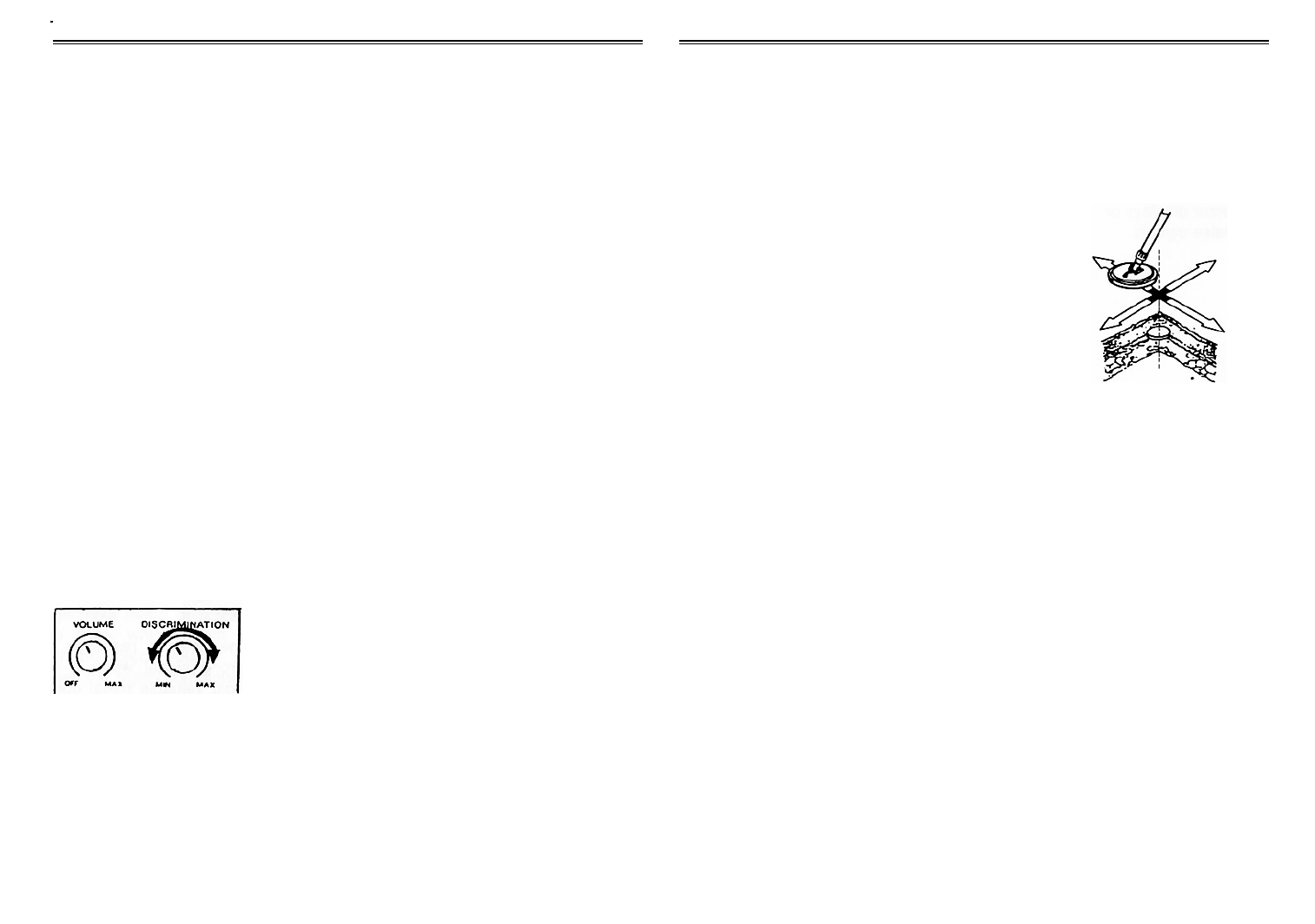
cC
6. Try finding other metal in the area. When
you find a metal item, wait a few seconds
after the tone stops before continuing, to allow
the detector time to reset (or, press the red
button on the handle to return the pointer to
the center of the view meter).
FINE-TUNING THE DETECTOR
After you become familiar with how your
detector works, you can fine-tune it to make it
more selective in what it finds.
Discrimination is the detectors’ ability to
differentiate between types of metal. The
detector’s DISCRIMINATION setting
determines whether the detector will distinguish
between different types of ferrous and
non-ferrous metals.
You can set DISCRIMINATION to minimum
(fully counterclockwise), to maximum (fully
clockwise), or anywhere in between. As you set
DISCRIMINATION to higher levels, the
detector first does not detect small pieces of
silver paper, then thick foil, and finally metal
objects like pull tabs from aluminum cans.
PINPOINTING A TARGET
Accurately pinpointing a target makes digging
it up easier.
Accurate pinpointing takes practice, and we
suggest you practice finding and digging up
small metal objects on your own property
before you search other locations.
Sometimes, targets are difficult to accurately
locate due to the sweep direction. Try
changing your sweep direction to pinpoint a
target.
Follow these steps to pinpoint a target.
1. When the detector detects a buried target,
continue sweeping the search coil over the
target in narrowing side-to-side motion.
Make a visual note of the exact spot on the
ground where the detector beeps.
2. Stop the search coil directly over this spot
on the ground. Then move the search coil
straight forward away from you and
straight back toward you a couple of times.
Make a visual not of the exact spot on the
ground there the detector beeps.
Note: Each time you use the detector in a different
area, you must adjust DISCRIMINATION. Each
search location presents new challenges.
FALSE SIGNALS
Because your detector is extremely sensitive,
trash-induced signals and other sources of
interference might cause signals that seem
confusing. The key to handling these types of
signals is to dig for only those targets that generate
a strong, repeatable signal. As you sweep the search
coil back and forth over the ground, learn to
recognize the difference between signals that occur
at random and signals that are stable and
repeatable.
To reduce false signals when searching very trashy
ground, scan only a small area at a time using slow,
short overlapping sweeps.
DETECTION HINTS
No detector is 100 percent accurate. Various
conditions influence metal detection. The detector’s
reaction depends on a number of things:
z The angle at which the object rests in the
ground
z The depth of the object
z The amount of iron in the object
z The size of the object
3. Repeat Steps 1-2 at a right angle to the
original search line, making an “X” pattern.
The target should be directly below the “X”
at the point of the loudest response.
Note:
z If trash in an area is so heavy that you get
false signals, slow your sweep speed and use
shorter sweeps.
z Recently buried coins might not respond the
same as coins buried for a long period of
time because of oxidation.
z Some nails, nuts, bolts, and other iron
objects (such as old bottle caps) oxidize and
create a “halo” effect. A halo effect is caused
by a mixture of natural elements in the
ground and the oxidation created by
different metals. Because of the metal
mixtures, target signals might not be in a
“fixed” position. This effect makes these
objects very hard to detect accurately. (See
“Fine-Tuning the Detector” on Page 10.)








